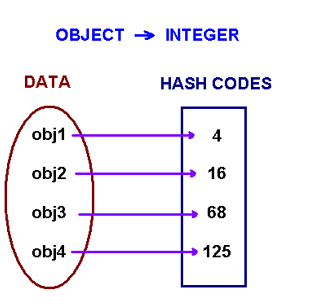
| The problem at hands is to speed up searching. Consider the problem of searching an array for a given value. If the array is not sorted, the search might require examining each and all elements of the array. If the array is sorted, we can use the binary search, and therefore reduce the worse-case runtime complexity to O(log n). We could search even faster if we know in advance the index at which that value is located in the array. Suppose we do have that magic function that would tell us the index for a given value. With this magic function our search is reduced to just one probe, giving us a constant runtime O(1). Such a function is called a hash function . A hash function is a function which when given a key, generates an address in the table. |  |
The example of a hash function is a book call number. Each book in the library has a unique call number. A call number is like an address: it tells us where the book is located in the library. Many academic libraries in the United States, uses Library of Congress Classification for call numbers. This system uses a combination of letters and numbers to arrange materials by subjects.
A hash function that returns a unique hash number is called a universal hash function. In practice it is extremely hard to assign unique numbers to objects. The later is always possible only if you know (or approximate) the number of objects to be proccessed.
Thus, we say that our hash function has the following properties
The precedure of storing objets using a hash function is the following.
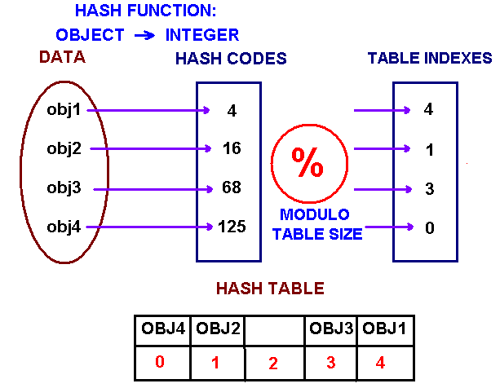
How to choose a hash function? One approach of creating a hash function is to use Java's hashCode() method. The hashCode() method is implemented in the Object class and therefore each class in Java inherits it. The hash code provides a numeric representation of an object (this is somewhat similar to the toString method that gives a text representation of an object). Conside the following code example
Integer obj1 = new Integer(2009);
String obj2 = new String("2009");
System.out.println("hashCode for an integer is " + obj1.hashCode());
System.out.println("hashCode for a string is " + obj2.hashCode());
hashCode for an integer is 2009 hashCode for a string is 1537223
The method hasCode has different implementation in different classes. In the String class, hashCode is computed by the following formula
s.charAt(0) * 31n-1 + s.charAt(1) * 31n-2 + ... +
s.charAt(n-1)"ABC" = 'A' * 312 + 'B' * 31 + 'C' = 65 * 312 + 66 * 31 +
67 = 64578
Note that Java's hashCode method might return a negative integer. If a string is long enough, its hashcode will be bigger than the largest integer we can store on 32 bits CPU. In this case, due to integer overflow, the value returned by hashCode can be negative.
Review the code in HashCodeDemo.java.
When we put objects into a hashtable, it is possible that different objects (by the equals() method) might have the same hashcode. This is called a collision. Here is the example of collision. Two different strings ""Aa" and "BB" have the same key: .
"Aa" = 'A' * 31 + 'a' = 2112
"BB" = 'B' * 31 + 'B' = 2112
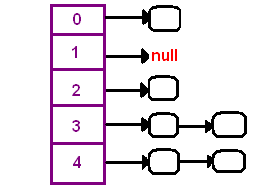 |
How to resolve collisions? Where do we put the second and subsequent values that hash to this same location? There are several approaches in dealing with collisions. One of them is based on idea of putting the keys that collide in a linked list! A hash table then is an array of lists!! This technique is called a separate chaining collision resolution. |
The big attraction of using a hash table is a constant-time performance for the basic
operations add, remove, contains, size. Though, because of collisions, we cannot
guarantee
the constant runtime in the worst-case. Why? Imagine that all our objects collide into the
same index. Then searching for one of them will be equivalent to searching in a list, that
takes a liner runtime. However, we can guarantee an expected constant runtime, if we make sure
that our lists won't become too long. This is usually implemnted by maintaining a load factor
that keeps a track of the average length of lists.
If a load factor approaches a set in advanced threshold, we create a bigger array and rehash
all elements from the old table into the new one.
Another technique of collision resolution is a linear probing. If we cannoit insert at index k, we try the next slot k+1. If that one is occupied, we go to k+2, and so on. This is quite simple approach but it requires new thinking about hash tables. Do you always find an empty slot? What do you do when you reach the end of the table?
In this course we mostly concern with using hashtables in applications. Java provides the following classes HashMap, HashSet and some others (more specialized ones).
HashSet is a regular set - all objects in a set are distinct. Consider this code segment
String[] words = new String("Nothing is as easy as it looks").split(" ");
HashSet<String> hs = new HashSet<String>();
for (String x : words) hs.add(x);
System.out.println(hs.size() + " distinct words detected.");
System.out.println(hs);
It prints "6 distinct words detected.". The word "as" is stored only once.
HashSet stores and retrieves elements by their content, which is internally converted into an integer by applying a hash function. Elements from a HashSet are retrieved using an Iterator. The order in which elements are returned depends on their hash codes.
Review the code in HashSetDemo.java.
The following are some of the HashSet methods:
You are implement a simple spell checker using a hash table. Your spell-checker will be reading from two input files. The first file is a dictionary located at the URL http://www.andrew.cmu.edu/course/15-121/dictionary.txt . The program should read the dictionary and insert the words into a hash table. After reading the dictionary, it will read a list of words from a second file. The goal of the spell-checker is to determine the misspelled words in the second file by looking each word up in the dictionary. The program should output each misspelled word.
See the solution here Spellchecker.java.
HashMap is a collection class that is designed to store elements as key-value pairs. Maps provide a way of looking up one thing based on the value of another.
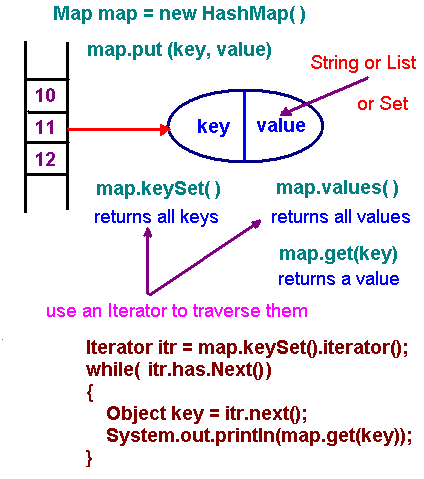
We modify the above code by use of the HashMap class to store words along with their frequencies.
String[] data = new String("Nothing is as easy as it looks").split(" ");
HashMap‹String, Integer> hm = new HashMap‹String, Integer>();
for (String key : data)
{
Integer freq = hm.get(key);
if(freq == null) freq = 1; else freq ++;
hm.put(key, freq);
}
System.out.println(hm);
This prints {as=2, Nothing=1, it=1, easy=1, is=1, looks=1}.
HashSet and HashMap will be printed in no particular order. If the order of insertion is important in your application, you should use LinkeHashSet and/or LinkedHashMap classes. If you want to print dtata in sorted order, you should use TreeSet and or TreeMap classes
Review the code in SetMapDemo.java.
The following are some of the HashMap methods:
An anagram is a word or phrase formed by reordering the letters of another word or phrase. Here is a list of words such that the words on each line are anagrams of each other:
barde, ardeb, bread, debar, beard, bared bears, saber, bares, baser, braes, sabre
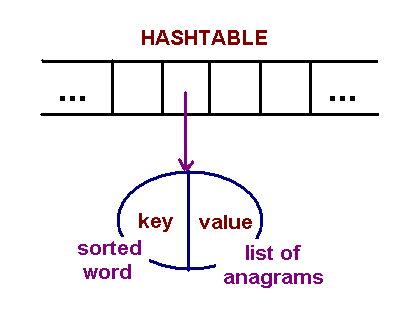
See the solution here Anagrams.java.